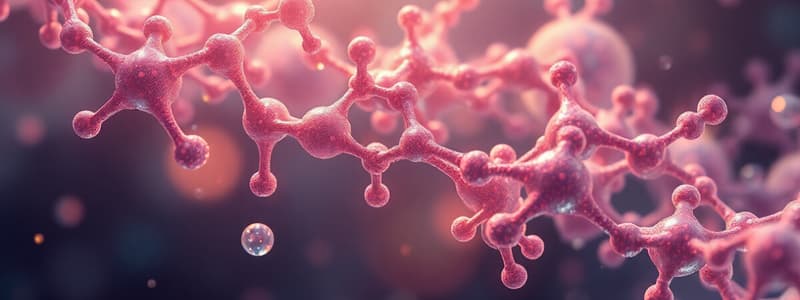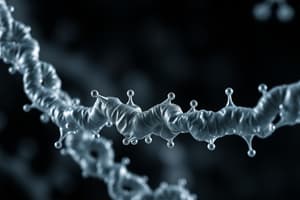Podcast
Questions and Answers
Carbohydrates provide ______ kilocalories per gram when we eat.
Carbohydrates provide ______ kilocalories per gram when we eat.
4
The most common monosaccharide is ______.
The most common monosaccharide is ______.
glucose
Polysaccharides such as starch and glycogen are made of ______ or more monosaccharides.
Polysaccharides such as starch and glycogen are made of ______ or more monosaccharides.
three
Lipids provide ______ kilocalories per gram when we eat.
Lipids provide ______ kilocalories per gram when we eat.
The building blocks of lipids are glycerol and ______ fatty acids.
The building blocks of lipids are glycerol and ______ fatty acids.
Cellulose provides ______ support in plants.
Cellulose provides ______ support in plants.
Saturated fats are typically ______ at room temperature.
Saturated fats are typically ______ at room temperature.
Unsaturated fats contain at least one ______ or triple bond between carbons.
Unsaturated fats contain at least one ______ or triple bond between carbons.
Liquid at room temperature mainly includes plant-based fats such as ______ oil.
Liquid at room temperature mainly includes plant-based fats such as ______ oil.
We get 4 kilocalories per gram of ______ when we eat.
We get 4 kilocalories per gram of ______ when we eat.
Proteins are essential for growth and ______.
Proteins are essential for growth and ______.
The monomer of proteins is ______ acids.
The monomer of proteins is ______ acids.
______ acids provide our genetic information.
______ acids provide our genetic information.
A nucleotide is made up of sugar, phosphate, and a ______ base.
A nucleotide is made up of sugar, phosphate, and a ______ base.
Hemoglobin in red blood cells is an example of a ______.
Hemoglobin in red blood cells is an example of a ______.
Flashcards
Carbohydrate Monomer
Carbohydrate Monomer
A single sugar molecule, like glucose or fructose; the building block of carbohydrates.
Carbohydrate Polymer
Carbohydrate Polymer
A large molecule formed from many linked sugar molecules, like starch or glycogen.
Starch
Starch
A polysaccharide used for energy storage in plants.
Glycogen
Glycogen
Signup and view all the flashcards
Cellulose
Cellulose
Signup and view all the flashcards
Lipid Monomer
Lipid Monomer
Signup and view all the flashcards
Saturated Lipid
Saturated Lipid
Signup and view all the flashcards
Unsaturated Lipid
Unsaturated Lipid
Signup and view all the flashcards
Proteins: Muscle Enhancer
Proteins: Muscle Enhancer
Signup and view all the flashcards
Protein Function
Protein Function
Signup and view all the flashcards
Protein Building Blocks
Protein Building Blocks
Signup and view all the flashcards
Nucleic Acids: DNA Component
Nucleic Acids: DNA Component
Signup and view all the flashcards
Nucleic Acid Function
Nucleic Acid Function
Signup and view all the flashcards
Nucleic Acid Building Blocks
Nucleic Acid Building Blocks
Signup and view all the flashcards
What is the difference between DNA and RNA?
What is the difference between DNA and RNA?
Signup and view all the flashcards
Study Notes
Biology 8 - Unit 2: Life Processes of Living Things
- Theme: Live 5C's (Competence, Character, Commitment to Achieve, Collaboration, Creativity) achieved through academic rigor, growth mindset and grit
- Unit Focus: Biomolecules including carbohydrates, lipids, nucleic acids, and proteins
Biomolecules
- Definition: Carbohydrates, lipids, nucleic acids, and proteins are essential organic molecules that make up living organisms.
- Note: These biomolecules are not necessarily obtained from food (nucleic acids)
Carbohydrates
- General Info:
- Most common organic molecule vital for the body's energy needs
- Elements: Carbon, Hydrogen, Oxygen (1:2:1 ratio)
- Function: Main energy source
- Types of carbohydrates:
- Single sugar (monosaccharide): Glucose, fructose
- Two sugars (disaccharide): Maltose, sucrose
- Three or more sugars (polysaccharide): Starch, glycogen, cellulose, chitin
- Examples: Chocolate, bread, pasta, fruits, vegetables (all from plants)
- Polysaccharides:
- Starch: Energy storage in plants (e.g., potatoes, pasta, rice)
- Glycogen: Energy storage in animals (formed in the liver)
- Cellulose: Structural support for plants (in the cell wall)
- Chitin: Structural support for arthropods (insects, spiders) and some fungi (in cell walls)
- Energy Value: 4 kilocalories per gram
Lipids
- General Info:
- Function: Storing energy, insulation, and making up the cell membrane.
- Elements: Carbon, Hydrogen, Oxygen
- Monomer: Glycerol and 3 fatty acids
- Polymers: Phospholipids, triglycerides
- Types:
- Saturated: Solid at room temperature, single bonds between carbon atoms (e.g., animal fats)
- Unsaturated: Liquid at room temperature, at least one double or triple bond between carbon atoms (e.g., plant-based oils)
- Energy Value: 9 kilocalories per gram
Proteins
- General Info:
- Function: Transport molecules in and out of cells, control chemical reactions, essential for growth and repair, fundamental structural components
- Composed of C, H, O, and N
- Monomer: Amino acids (20 different kinds)
- Polymer: Proteins (various types)
- Examples: Hemoglobin (in red blood cells), albumin, enzymes, antibodies
- Food Sources: Fish, eggs, meat, and so on
- Energy Value: 4 kilocalories per gram
Nucleic Acids
- General Info:
- Function: Store genetic information; instructions for making proteins
- Elements: C, H, O, N, P
- Monomer: Nucleotides (sugar, phosphate, nitrogenous base)
- Types: DNA and RNA (and ATP)
- Examples DNA (genetic code), RNA (protein recipe), ATP (energy carrier)
Studying That Suits You
Use AI to generate personalized quizzes and flashcards to suit your learning preferences.




